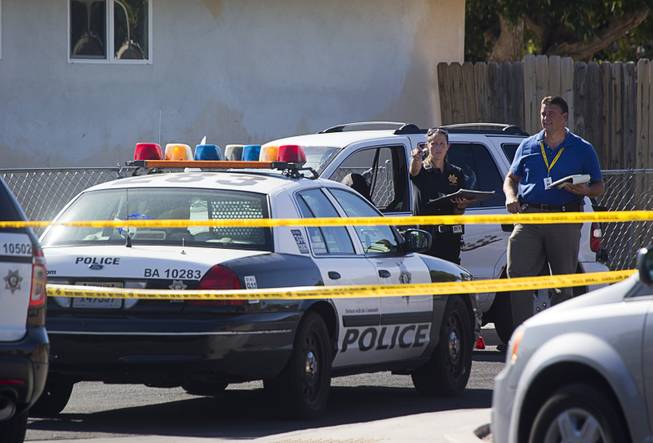
A Metro Police detective and crime scene analyst investigate a double shooting near Tonopah Drive and Washington Avenue Wednesday, June 1, 2016.
Monday, June 27, 2016 | 2 a.m.
Homicides in the jurisdiction of Las Vegas Metro Police from Jan. 1 to June 3:
GENDER: Male, 61; Female, 14 RACE: Hispanic, 28; Black, 24; White, 19; Asian, 2; Native American, 1; Pacific Islander, 1 AGE: Teens, 10; 20s, 28; 30s, 15; 40s, 12; 50s, 5; 60s, 4; 90s, 1 TYPE OF HOMICIDE: Dispute, 29; Unknown, 19; Domestic Violence, 10; Crime in Progress, 7; Drugs, 6; Love Triangle, 3; Accidental, 1 METHOD: Firearms, 61; Stabbed/Cut, 7; Blunt Trauma, 5; Thermal Burns, 1; Pending, 1
Sunlight glares, the heat sweltering into triple digits as a woman steps to a microphone in front of a dirt lot in southwest Las Vegas.
“Anyone,” she pleads. “Come forward to solve this case for my dad, for my family, because he didn’t deserve this. He deserved to be here with us.”
This June 1 afternoon, 27-year-old Amber Santee is holding her father's photograph, asking the public to help solve his murder. Several weeks before, security guard Mark Steven Santee had been shot in the head multiple times during a burglary at this construction site, a few feet from where Amber is standing. Santee's obituary said he left behind his wife of 30 years, three children and his own parents. He was 48.
Police said there were signs he fought back, and they released a video of a pickup truck that may have been involved — red or orange, a newer-model Chevrolet Avalanche.
“He was hard-working. He did right by the community. He did what everybody else does: go to work, come home, pay his bills, help anybody in need … Knowing that he’s not here is hard. Very hard,” Amber says, fighting tears. She urges the assailants to come forward. “Either way, they’re going to get caught; it’s a matter of time.”

Amber Santee holds a photo of her father, Mark Santee, during a Metro Police news conference Wednesday, June 1, 2016, by an apartment complex under construction at Jerry Tarkanian Way and Hacienda Avenue. Security guard Mark Santee was shot and killed at the site in April. In the background, Metro Police’s victim advocate Regina Porter, right, stands with Amber’s mother, Nicole Santee.
Metro Police Lt. Dan McGrath heads up the 19-detective homicide unit tasked with getting it done. Despite the heat, his pinstripe shirt is buttoned all the way up, dark tie hanging near the gun on his belt. He emphasizes the vehicle of interest and the potential reward for information, describing Santee as an innocent man “just doing his job.”
This won’t be the only briefing McGrath gives before sundown. Within a few hours, five more people will violently die in Las Vegas.
• • •
“From the Las Vegas Strip, you can’t tell that 60 people have been murdered in Las Vegas this year,” FBI Director James Comey said in May, addressing national media about the troubling rise in violent crime in several major American cities. Politico reported that Comey was briefed on quarterly stats for about 40 metro areas and indicated “most of them have seen increases.”
That grim reality is echoed by the Major Cities Chiefs Association of police executives. Among 63 cities in the U.S. and 10 in Canada, about half saw increases in the first quarter of 2016, from Los Angeles and Phoenix to San Antonio and Chicago, though the trend is not universal. Other cities saw homicide rates decline. And in some cases, the two sides of the spectrum aren’t far apart on the map: Houston had 10 fewer killings than last year, while nearby Dallas reported 45, up from 26.
A sampling of cities that saw increases and decreases in homicides in the first quarter:
INCREASES: Chicago: 141 (83 in 2015); Dallas: 45 (26); Jacksonville: 30 (18); Los Angeles: 73 (55); Memphis: 48 (31); San Antonio: 34 (23) DECREASES: Detroit: 61 (69 in 2015); Houston: 61 (71); Miami: 12 (25); Milwaukee: 24 (30); New York City: 68 (85); Oakland: 16 (23)
That’s a 73 percent spike. But during the same January-through-March period in Las Vegas, homicides were up 82 percent, and by the end of April the figure had swelled to 106 percent. Clark County Sheriff Joe Lombardo’s comment at the time: “The forest is on fire.”
While the increase over 2015’s numbers has come back down to around 50 percent as of June 26, 84 murders have been documented in Metro’s jurisdiction. Lombardo said violent crime started to swell in 2014 but began to “show legs” this year. It was especially obvious that first day of the month, when five brutal deaths happened in Las Vegas, four classified as homicides. Detective McGrath was Metro’s voice at three of the scenes.
From the Santee site, he went about 10 miles north to a gated community in Summerlin, where a man with apparent mental illness was believed to have fatally stabbed and shot his parents before taking his own life. McGrath called it a “family tragedy.”
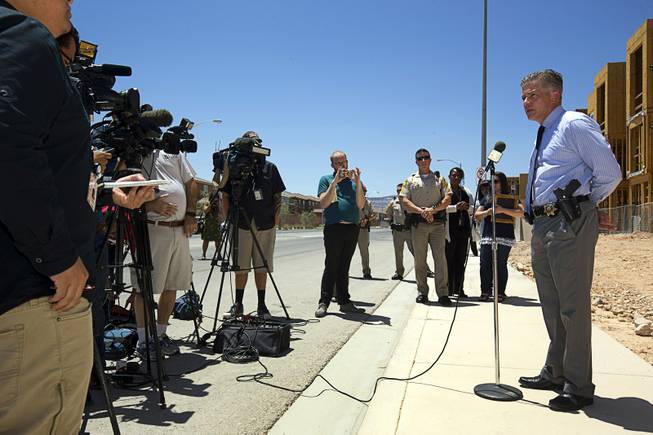
Metro Police Lt. Dan McGrath, of the LVMPD homicide section, speaks during a news conference by an apartment complex under construction at Jerry Tarkanian Way and Hacienda Avenue Wednesday, June 1, 2016. Security guard Mark Santee was shot and killed at the site in April.
The next scene, on Washington Avenue near Tonopah Drive, was blocked off by police tape. Onlookers saw a trail of cones marking bullet casings leading to a small white SUV, where two teens, 17 and 19, were gravely wounded after an argument and car chase. This past Wednesday, police arrested an 18-year-old and a 19-year-old on counts of first-degree murder and other charges related to the killings, which happened in the middle of a street in broad daylight.
Theorizing on homicide spikes across the country, department leaders in the Major Cities Chiefs Association spent a recent conference discussing everything from the proliferation of firearms and opiate abuse to prison-population and sentencing reforms that have led to the early release of inmates, Lombardo said.
Was a conclusion reached? “Not necessarily,” he said. “To put our finger on one definite issue is impossible, but I think we’ll get a better picture as we move forward.”
Other factors officials have chewed on in recent weeks range from decentralization of police to “the Ferguson Effect,” in which officers stand down or become more passive in potentially violent scenarios so as not to draw public scrutiny. But criminologists warn against drawing broad conclusions about what’s behind fluctuations in murder rates.
The murder rate at large:
U.S. murder rates in recent years are some of the lowest in the past century. (National numbers are not yet available for 2015 and 2016.) Despite the current spike over Las Vegas' 20-year low of 5.14 homicides per 100,000 residents in 2012, the figure was as high as 12.2 in 1995.
William Sousa, director of UNLV’s Center for Crime and Justice Policy, said that during a downward trend — which the U.S. has experienced over the past 20 years — it wasn’t unusual to see a fluctuation over a one- or two-year period. There is no specific explanation for such anomalies, as it’s difficult to analyze numbers in such short spans. “That which is difficult to predict is difficult to prevent,” Sousa said.
That's no help to Las Vegans trying to make sense of the numbers. Along with the loss of life, this trend is stirring up fear that can have profound weight.
“I constantly think about it every day,” Amber Santee said of her father’s death. “I fear more now. I watch the news way more now. So I’m constantly aware of the homicides that are going on, and it’s just devastating.”
Even if we can't predict the events conjuring that fear, it is possible to break down what murder actually looks like in our valley, and some of the ways community forces are addressing it — through legislation, the criminal justice system, social services, education or a few Las Vegans walking the hot streets looking for “forgotten” souls who could be helped to the other side of the statistics.
Breaking Down Murder in Las Vegas
Crime in Progress
Two weeks shy of his 25th birthday, Matthew Christensen was gunned down as he held up his hands. The clerk was doing what he’d been told by a trio of robbers at a southwest valley Lee’s Discount Liquor store on April 18.
Known as a “jokester” by family, a guy who enjoyed video games, anime and "Game of Thrones," Christensen died hours later. It was a senseless and “stupid, stupid murder,” Clark County District Attorney Steve Wolfson said the next day. Two of the alleged assailants were arrested on the victim’s birthday. As authorities closed in, the third surrendered.
Around 1:15 a.m. on Feb. 20, Heriberto Diaz Marcial was five houses from his own when a bullet tore into his chest. The 60-year-old had taken the bus from his job at a Strip casino and was walking near Lake Mead Boulevard and Marion Drive, where a group of teenagers mugged him at gunpoint. Police said he didn’t resist the robbery that claimed his life, the teen perpetrators taking only his cellphone.
On the sidewalk where McGrath and other Metro officers spoke about the slaying, which could be related to a string of armed robberies, lay a makeshift memorial of eight candles and multicolored flowers. A photo of Diaz Marcial was taped to a light pole. “Those are difficult cases, because you really have to feel for their family,” McGrath said of the way Diaz Marcial, Christensen and Santee just went to work one day and never came home.
Still, killings tied to crimes in progress — seven definitive cases so far in 2016 — are “very rare.”
Violent crime — comparing Las Vegas to New York City:
The NYPD has reported an 81 percent reduction in homicide and a 75 percent decrease in crime since 1993, Police Commissioner William J. Bratton said in a January news release. And 2015 was that city’s “safest year in modern history,” with the lowest murder and robbery rates in 50 years. The department credits resources, police/community relations, “precision-policing” in higher-crime pockets and “discretion in enforcement and reducing the number of enforcement encounters across the city.”
Domestic Violence
After allegedly stabbing 19-year-old Chelsey Lagle on March 29, her boyfriend, Skyler Fowler, called 911 to say he had “beat her to f-----g death.” A naked Fowler was arrested after speeding through an apartment complex gate and crashing into a convenience store. Neighbors told detectives they’d heard the couple arguing and screaming, yet they didn’t call police, McGrath said.
Based on stats from Jan. 1 to June 3, about 13 percent (10) of the murders in Las Vegas this year involved a domestic dispute. In any given year, such killings amount to about a quarter of violent deaths, McGrath said. Fatal or not, violence between intimate partners is the source of 15 percent of all violent crime in the U.S., according to the Department of Justice's Bureau of Justice Statistics. But that only reflects what gets told to police. McGrath said homicide cases where domestic abuse went unreported are the ones that haunt his team.
Take Natalia Cruz, fatally stabbed by her partner on May 16 in the 4800 block of Vegas Valley Drive. There were indications Cruz suffered abuse, a friend told Metro investigators, though it was never reported. “Maybe we could’ve stopped it,” McGrath said. “Maybe not, but you always have to wonder if something else could have been done.”
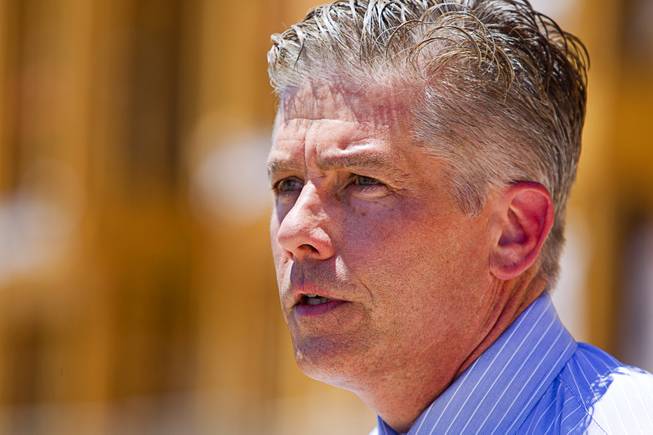
Metro Police Lt. Dan McGrath of the LVMPD homicide section, speaks during a news conference by an apartment complex under construction at Jerry Tarkanian Way and Hacienda Avenue Wednesday, June 1, 2016. Security guard Mark Santee was shot and killed at the site in April.
Hannah Brook, director of community and donor relations at local shelter and advocacy group Safe Nest, said its services were sought about 50,000 times last year, including visits and calls to the hotline — a slight increase from 2014. While the shelter can handle that volume, Brook says, funding can be a challenge in meeting the community’s need for crisis response. Regarding crisis prevention, Brook said there is no way to predict if or when someone will snap and kill a partner. That’s partly because, McGrath says, “you can’t be in people’s houses to see what’s going on in the family structure.”
But there are red flags the public and the justice system could be better trained in seeing, Brook said, including body language between the victim and alleged attacker, specific marks on the skin — bruising or injuries for which explanations don’t make sense — and controlling or strained behavior. Police are already trained to spot those cues, but Brook said it’s important that they’re consistent in their responses.
Metro’s Family Justice Center, slated to open in early October, will offer interventional resources for people struggling with domestic violence, says Elynne Greene, manager of Metro’s Victims Services and Human Trafficking unit.
At Mojave Road between Washington and Bonanza, a Metro training center will transform into the multiagency hub, which should improve access to services from law-enforcement and advocate groups by housing them under one roof. The Family Justice Center will be the first of its kind in Nevada, though similar centers are operating nationally and internationally, Greene says, adding that cities using the model have seen decreases in domestic-violence homicides and increases in victim safety and empowerment.
“We’re going in the right direction,” Brook said, noting that more could always be done.
Mental Illness
Aaron Wulf, the 36-year-old accused of killing his parents and himself on June 1, exhibited signs of mental illness, McGrath said.
Wulf sent a manifesto — hundreds of typed pages and audio and video recordings — to family members, police and news media in three cities. Metro received it after the murder-suicide.
Number of homicides in Henderson and North Las Vegas in the first quarter:
Henderson, 4; North Las Vegas, 10
“We can look at the act and then look backward,” Sousa said. Because predicting when a mentally ill person might resort to lethal violence bears a similar challenge to trying to see it coming in an abusive relationship. “The overwhelming number of people with those warnings signs will never escalate to that degree,” the criminologist explained. Of the 75 killings recorded through June 3, reports indicated that three suspects showed signs of mental illness.
If someone is concerned about a person’s mental state, a 911 call is the first step, said Martha Framsted of the Nevada Department of Public and Behavioral Health. McGrath says calls are kicked to a Crisis Intervention Team officer trained to de-escalate tense situations involving the mentally ill.
Nevada’s deficient mental-health services are well documented, and according rankings can be found on the website of the national Treatment Advocacy Center. Regarding the quality of laws, the state gets a C grade for emergency evaluation and an F for inpatient commitment, meaning there are only 11.2 clinical beds per 100,000 people (50 is the recommended minimum, though no state meets it). It’s a problem, considering that in 2015, the Treatment Advocacy Center estimated 24,000 Nevadans suffered from schizophrenia, and 48,000 from severe bipolar disorder.
Dangerous Lifestyles
The majority of recent homicides have stemmed from disputes, Metro stats show. In most cases, the victims knew the alleged perpetrators, and killings were often connected to criminal activity such as pimping, pandering, robbery and drugs, violence sometimes erupting over "small amounts" of marijuana, McGrath said. Six homicides from Jan. 1 to June 3 were specifically related to drugs.
“When you’re involved in criminal activity, there’s a higher likelihood that you can end up getting shot or killed,” McGrath said.
Sousa agrees that violence can catch up with dangerous lifestyles. “The suspect of today is the victim of tomorrow,” he said.
Youth and Guns
The quiet near an east-valley mountainside was broken the morning of April 23 by about 60 gunshots. The melee at the Hollywood Recreation Center left five injured: a man with a stab wound to the neck and four teenagers shot, one fatally. Hours later, police and religious leaders consoled the family of Angelo Barboza, 15.
"I was able to say I love him," the teen's mother, Crystal, said at a vigil, recalling Angelo's reply: "'I love you, too, Mom. I'll be back in a couple of hours.' A couple of hours never came."
Another teenager was booked in the case, one of three murder arrests this year involving a suspect under age 17, McGrath said. “Some of these are younger people. That should be a concern of everybody in the community.”
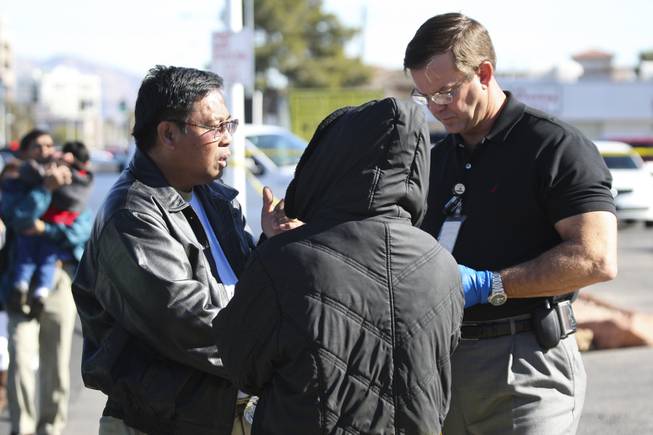
Metropolitan Police Officer Clifford Mogg, right, speaks with potential witnesses in the death of Dr. Edna Makabenta on Monday. The two being interviewed had been parked in front of the doctor's West Charleston office, where a police said a patient killed the doctor then killed himself.
At First Tuesday, Metro’s monthly effort to engage residents of its various area commands, Detective Cliff Mogg spoke. He has investigated homicides here for over 20 years, and said police were seeing suspects “a lot younger.” It may be the only definite trend Metro has identified in the homicide spike.
One theory is that teens are more likely to pull the trigger during arguments over trivial matters without thinking of the profound consequences, McGrath says. "At what point have we shifted in society to have these young people go from an argument to shooting at people?"
Each case involving a juvenile shooter is unique and multifaceted, but “the use of weapons among young people generally suggests a leveling of the playing field," said Dr. Ellen Stein, a forensic and clinical psychologist based in San Diego. "When younger people feel disempowered, the gun affords them a greater sense of potency and ability to navigate their world.”
The connection to violence may be intensified in Las Vegas as a side effect of home invasions. Mogg says the valley has seen an increase in weapons stolen this way, arming offenders who might not be able to buy them otherwise. To counter that, Metro has released public-service announcements advising gun owners to secure them, and gave out gunlocks at a recent First Tuesday.
What Might Impact the Rising Homicide Rate
Officer Shortage
Metro covers about 1.5 million residents in its jurisdiction. That translates to 1.7 officers per 1,000 residents, not including Las Vegas’ roughly 42 million yearly tourists, who account for 20 percent of the department’s workload. Lombardo would like to see that number climb to at least 2 officers per 1,000. The department employs 2,501 officers as of June 21, so that increase would boost the force by about 425.
“Currently, the economic climate will not let me achieve that number,” he has said.
Finding the money has been the subject of heated exchanges across government entities in Southern Nevada. On June 7the Las Vegas Sun reported on “the verbal feud” between the City Council and Clark County Commission over who is doing more to address homicide rates. In June, city officials allocated $440,000 to help fund a Metro project focused on targeted policing in high-crime areas. And Clark County will soon decide whether to add $1 million a year to Metro’s coffer.
More officers could have a positive effect, Sousa said, but they must be specifically deployed to fight crime. That’s because the majority of police work involves calls to “a great many things that are very important to do but aren’t really crime-related,” he said, listing medical situations, traffic accidents and family disturbances.
While he didn’t go into detail, Lombardo said public-safety issues will be pushed in the 2017 legislative session.
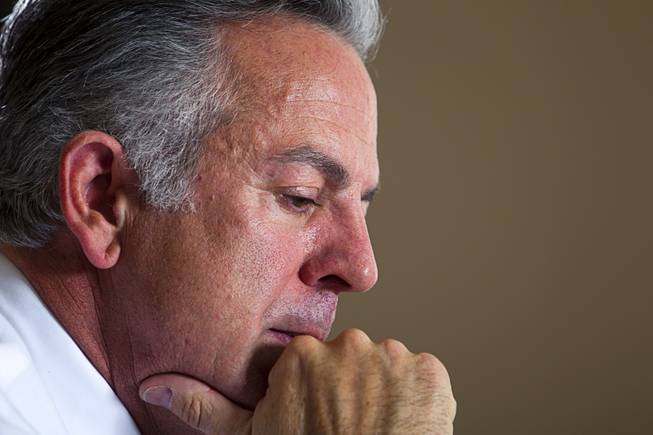
Clark County Sheriff Joe Lombardo considers a question during a meeting with Las Vegas Sun reporters and editors Tuesday, March 24, 2015, at Las Vegas Metro Police headquarters.
Decentralized Gang Unit
In about half of the homicides this year, the victim, suspect or both have had gang ties, Lombardo said. But numbers haven’t shown that the inflated homicide rate is related to traditional battles. In fact, there hasn’t been a murder this year where gang motivation or the furthering of a gang’s cause could be substantiated.
Gangs used to feud over colors and turf. Now, Lombardo said, there are hybrid groups that include members from all races with different motivations. “It’s more economic and drug-sales driven.”
Metro decentralized several of its branches last year, including the gang unit. This dispersed officers to the different substations, and critics have argued that put a “dent” in enforcement and investigation, said Mark Chaparian, executive director of the Las Vegas Police Protective Association representing thousands of Metro officers. Chaparian explained that in the centralized model, specialized officers focused on enforcement in the field while specialized investigators followed up with prosecutors and provided intelligence to field officers, whereas the new model could dispatch them on calls that have nothing to do with gang activity.
Capt. Robert Plummer, who heads the Bolden Area Command in the central valley, says decentralization has proven effective.
“I, as a bureau commander, have more control over how I deploy my gang resources,” Plummer said, adding that gang officers were out enforcing every night. In fact, the night before he was interviewed for this story, he said his team arrested six gang members and seized drugs and four guns.
Lombardo has said gang problems can vary in each area command, such that dividing officers has familiarized them with specific area gangs instead of having them canvass the entire city. He noted that there were still a centralized intelligence unit and two federal task forces associated with gang enforcement.
Decentralization has allowed better inter-departmental communication and facilitated resources at each area command, McGrath asserted. He, Plummer and Sousa agree it may just be a matter of time for the model to show its full potential.
Ferguson Effect
FBI Director Comey has notably said that aggressive officer interactions captured on viral videos, called the “Ferguson Effect,” could hamper police work and therefore be a factor in rising crime.
"Mr. Comey was wading back into a dispute from last fall that pitted him against some of his bosses at the White House and the Justice Department and one that roiled racial tensions over confrontations between police officers and minorities," The New York Times reported in May, adding that Obama administration officials have said they see no evidence of what Comey suggests.
Richard Rosenfeld, a prominent criminology professor at the University of Missouri at St. Louis, said that if the Ferguson Effect is valid then a drop in officer-initiated interactions with citizens would be reflected, and locally that has not been the case. Metro stats show that during the first five months of 2016, vehicle stops were up about 6 percent over 2015, stops of people on foot were up about 1 percent, and most telling was a 117 percent rise in field interviews.
Lombardo confirmed that the effect was not playing out here, though he said Comey’s point was taken out of context.
Being recorded can “weigh” on officers, Chaparian said, as split-second decisions made in the field can draw intense scrutiny. Camera or no, he emphasized that the officers he represents “are not afraid to do their job.”
California Jail Depopulation
Lombardo said Metro had recently seen a 26 percent increase in interactions with Californians during investigations of violent crime, some having history with that state’s penal system.
Since the U.S. Supreme Court ordered California to reduce its inmate population several years ago, some felons serving time for nonviolent and nonsexual acts have been transferred from prison to jail or had their terms cut short. Parole supervision and time served for violating parole also have been reduced, and Lombardo said the impacts can be felt in our valley through an influx of gang activity. After conferring with Los Angeles County Sheriff Jim McDonnell and LAPD Commander Kevin McCarthy, he said they agreed the interstate drift of criminal activity was real.
Emily Salisbury, an associate professor of criminal justice at UNLV and coauthor of a research paper examining whether downsizing prisons has been dangerous in California (specifically in regard to the effects of Assembly Bill 109, which initiated prison-to-jail transfers and reduced parole conditions), labeled that assessment “highly speculative.”
She said that increased interactions with Californians didn’t mean they were causally related to an increase in violence in Las Vegas.
Ways the Community is Taking Action
Legislation
“I’m sick and tired of waking up in the morning and the first thing I hear on the news is how somebody got shot and killed; how a teenager was murdered senselessly. We have too many guns out there,” said DA Wolfson.
A gun owner who supports the Second Amendment, Wolfson has endorsed Question One, a November ballot initiative that would require anyone trying to transfer or sell a gun to go through a licensed dealer, who would in turn run a background check on the buyer.
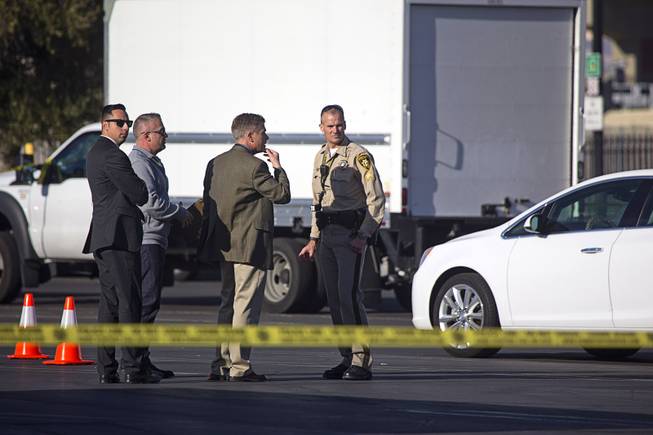
Metro Police detectives confer near a homicide scene by the Terrible's gas station at Rainbow Boulevard and Westcliff Drive Thursday, Feb. 4, 2016.
Lombardo hasn’t taken a stand. “I would better serve evaluating and not putting my position in the way,” he said, adding, “I think they’re going in the right direction.”
“It’s not, on its own, going to cause our homicide rate to go down, but I do believe it will save lives,” Wolfson said.
There are people with “serious mental issues” and domestic-battery convictions who could easily buy a gun, especially at a trade show or online, he says. So the DA’s office added a prosecutor to its team focused on gun crimes. Its success rate is about 90 percent in jailing offenders, sentences typically ranging from 6.5 to 17.5 years.
Another aim of the beefed-up team is for communication between Metro and prosecutors regarding “suspects who pose a chronic problem” to flow more freely. And when it comes to reaching young people with messages about gun violence, Wolfson said his deputy DAs are working on an educational program geared toward students in middle school and high school.
Metro Initiatives
Twenty-four people were violently killed in April. Late that month, Metro launched its Neighborhood Engagement Team (NET), and the next month, only seven homicides were added to the books.
Plummer, who was instrumental in NET’s creation, said that in the first six weeks, the team of 20 officers under the command of one lieutenant and two sergeants netted 256 felony arrests, impounded 43 guns and identified 210 gang members. “The department is not at ease,” he said, but officers are encouraged by the difference they're seeing.
The team isn't just going to high-crime areas “arresting everybody,” Plummer said. It’s about community engagement that can lead to better intelligence, and officers looking for the “right stops.” The success of the model has Metro looking into creating additional teams to send to other parts of Las Vegas. That $440,000 in extra funding from the city has freed overtime money, allowing the creation of at least one more team that will soon be deployed, Lombardo said.
Before NET, detectives from multiple details, including SWAT and internal affairs, were put on patrol to gather intelligence from high-crime areas. At any time, there were 70 detectives patrolling. That initiative has since scaled back, with graduate cadets filling the positions as detectives go back to casework. A version will remain in place at least through the summer, which usually sees a rise in crime, Lombardo said.
And the department is looking for more long-term solutions.
“It takes time," Lombardo said. "Nothing happens overnight, and people need to have confidence that we’re doing the right thing.”
Community Outreach
The 109-degree weather kept the rest of the Mighty Men of Valor away; only Bryce, Charles and Jamar showed up to D Street on a recent Monday.
The trio belongs to the Greater New Jerusalem Church, which is part of D Street Strong. It’s an effort by the church, Metro’s Bolden Area Command and Muhammad Mosque 75. In the face of nasty rhetoric about religious differences, it's an example of Christians and Muslims working together to strengthen their neighborhood. “They just want the best for the community,” Plummer said.
Hours after a triple homicide in December, in which three people were executed in a robbery over small amounts of drugs, Plummer met with religious leaders in an effort to bolster community engagement. Not long after, the groups began canvassing. “They’re talking and they’re interacting and building relationships,” Plummer said. And through those efforts, Metro made an arrest in the case.
The mission isn’t just to gather intel for investigations. It’s also to address some of the circumstances that can contribute to people snapping and committing violent crimes. On any given Monday afternoon and Saturday morning, members of both groups walk the neighborhood looking for residents and passersby in need of social services. They ask individuals to fill out referral cards indicating their needs, from housing and life-skills classes to medical aid. The project has even helped some residents get the help they need to take care of nuisance warrants.
"They get into a cycle in which they can't work to pay the warrant or pay the warrant to get a job," Sgt. Kurt McKenzie said. "We're just trying to remove obstacles."
On that ruthlessly hot Monday, the Men of Valor collected eight referral cards. They've collected over 200 since February, passing the information to a volunteer case manager with Metro, who then distributes it to advocate groups.
“The community is excited about what we do,” Bishop James Rogers Sr. said of the project. He said it made his congregation aware of citizens who felt they’d been forgotten.
Since D Street Strong's inception, there hasn’t been a major crime in that area, Rogers said. And thanks to the relationships it has fostered, Metro is bringing little league baseball to the Bolden Area Command, the teams to be coached by officers and firefighters.
Building community is powerful. So is scaling solutions to community ills. McKenzie said D Street Strong is working because it’s focused on one small piece of Las Vegas. Different neighborhoods will need different tactics for engaging the community and reducing crime, Plummer said. But the important thing is, those conversations are happening.
Ways You Can Take Action
If you need help, have information about a crime or notice disturbing behavior, these resources are a good place to start:
Crime Response
Metro Police: 702-828-3111
North Las Vegas Police: 702-633-911
Henderson Police: 702-267-5000
Crime Stoppers: 702-385-5555, crimestoppersofnv.com
Social Services
Safe Nest: 702-877-0133, safenest.org
The Shade Tree: 702-385-0072, theshadetree.org
Nevada Division of Public and Behavioral Health 24-hour crisis call center: 775-784-8090, text “answer” to 839863
Treatment Advocacy Center: 703-294-6001, treatmentadvocacycenter.org
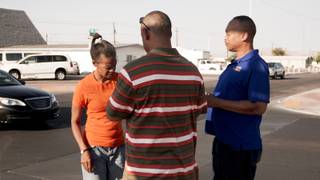

Join the Discussion:
Check this out for a full explanation of our conversion to the LiveFyre commenting system and instructions on how to sign up for an account.
Full comments policy